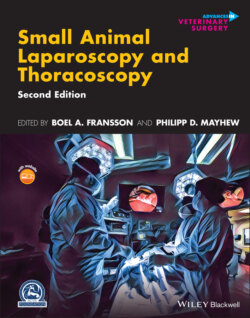Читать книгу Small Animal Laparoscopy and Thoracoscopy - Группа авторов - Страница 125
Key Points
ОглавлениеA basic understanding of electrosurgical devices is required to allow for appropriate use and prevention of morbidity relating to their use.
Three different types of coupling injuries can occur with monopolar devices: direct, indirect, and capacitive coupling.
Indirect coupling results from defects in the insulating coating of the electrode (instrument), often leads to large current densities concentrated in small areas, and can result in high‐morbidity injuries.
Tissue fusion technology or vessel sealant devices measure tissue impedance and deliver the appropriate amount of energy to achieve a safe seal. They are approved for sealing vessels up to 7 mm in diameter.
Meticulous hemostasis, one of Halsted's seven principles, is important for any surgery, but particularly for minimally invasive procedures, in which a small amount of hemorrhage can compromise visualization. Numerous devices are available for hemostasis with laparoscopy and thoracoscopy, including hemostatic clips, endostapling equipment, and energy devices.
Energy has been used in surgery for thousands of years. The first form of energy used in surgery was thermal cautery, or the application of energy as heat to tissues. Although this was invaluable for controlling hemorrhage, lateral thermal damage to normal tissues was extensive. This technology evolved as William T. Bovie developed the first electrosurgical unit (ESU) that provided both cutting and coagulation settings. Rather than electrocautery, which relies on the transfer of heat directly to tissues, this new technology created an electrical current that was applied to the tissues and, in turn, created heat. Almost 100 years later, we are still using monopolar and bipolar electrosurgical devices similar to the “Bovie,” but advances in technology have created safer units with more consistent tissue effects. More recently, vessel sealant technology has gained popularity in minimally invasive procedures. These bipolar electrosurgical devices have been used in numerous types of minimally invasive procedures, including surgeries of the reproductive tract, splenectomies, adrenalectomies, nephrectomies, lung biopsies, and pericardial surgery.
All surgeons should have a basic understanding of electrosurgical devices to allow for appropriate use of this equipment and to prevent unnecessary injury related to their use. Energy devices have their advantages and disadvantages for a given procedure, and it is up to the surgeon to understand the shortcomings of a particular device and decide which is the most appropriate for a given situation.
